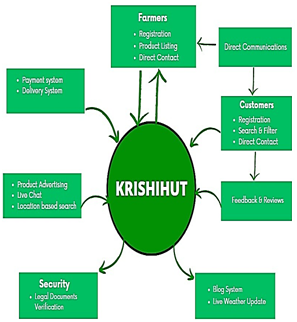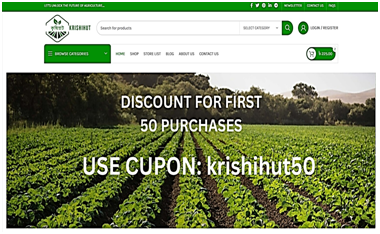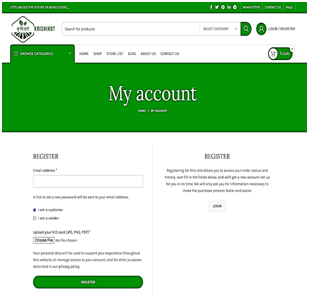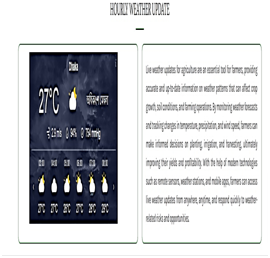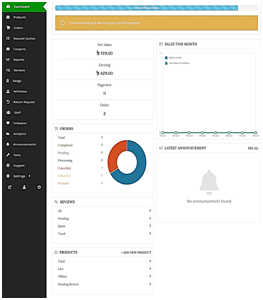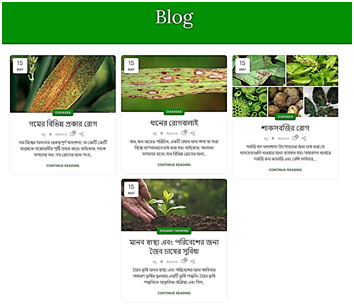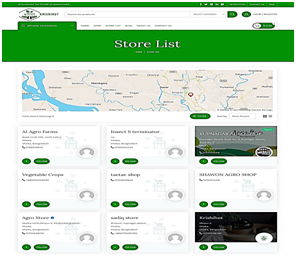Krishihut: A Multivendor-Based Agricultural Secure E-Commerce System for Reducing Price Hike in Bangladesh
- MD. Sadiqur Rahman
- MD. Ridoy Babu
- Ayesha Siddika
- Nazibul Basar Ayon
- Nusrat Jahan Tusti
- Sadah Anjum Shanto
- 01-09
- Sep 26, 2023
- Agriculture
Krishihut: A Multivendor-Based Agricultural Secure E-Commerce System for Reducing Price Hike in Bangladesh
1MD. Sadiqur Rahman,2MD. Ridoy Babu,3Ayesha Siddika,4Nazibul Basar Ayon,5Nusrat Jahan Tusti,6Sadah Anjum Shanto
Dept. of CSE BUBT
Dhaka, Bangladesh
DOI: https://doi.org/10.51584/IJRIAS.2023.8901
Received: 29 July 2023; Accepted: 29 August 2023; Published: 26 September 2023
ABSTRACT
Bangladesh places a high value on agriculture, but because of the country’s extreme poverty, individuals who work in it are currently from lower socioeconomic classes and face many challenges in their everyday life. Agriculture contributes around 5.3Lack of knowledge about cutting-edge techniques or technology contributes to farm poverty. Farmers still face pressure from market actors despite their effort and produce, which results in poverty. To enable direct sales between farmers and customers, middle men’s marketing-related roles must be eliminated. The section will offer advice to farmers on all topics, including the current market value of various products, the over- all market value and profitability of products sold, access to new e-learning farming techniques, various agricultural-related issues, and an inside look at various agricultural government strategies, such as agricultural compensation plans. By leveraging direct farmer to consumer connection and conversation with farmers, this website assists farmers in ensuring optimal profitability. Through this optimization platform, the farmer and the client can communicate more effectively.
Index Terms: Agriculture, Farmers, agents, customers, web- sites, and GDP (good domestic product).
INTRODUCTION
The goal of E-Agriculture is to enhance agricultural in addition to rural improvement by using various facts and verbal exchange techniques. The inspiration to use full-fledged potential of ICTs for agriculture capability building, and marketing has existed for a long time. It’s far just most currently the dissemination of records started out harnessing ICTs extra efficaciously for better provider delivery to the farmers.[1] Farming is the Prime Occupation in India in spite of this, today the people involved in farming belongs to the lower class and is in deep poverty. The Advanced techniques and the Automated machines which are leading the world to new heights, is been lagging when it is concerned to Farming, either the lack of awareness of the advanced facilities or the unavailability leads to the poverty in Farming. Even after all the hard work and the production done by the farmers, in today’s market the farmers are cheated by the Agents, leading to the poverty.[3] Technological importance has been a great support for making decisions in various fields especially in agriculture. The development of agriculture has been on under development for the past few years due to lack of Agriculture knowledge and environmental changes. The main aim of this paper is to reach farmers for their awareness, usage and perception in e-Agriculture. The study used statistical survey design technique to collect data from farmers for their awareness in e-Commerce. [4] A web program called Farmer E-Marketplace will assist farmers in developing agricultural marketing strategies that will raise their level of success and their standard of life. Farmers will be able to view orders placed and associated information on their accounts through the Marketing Center. Farmers will be able to sell their pro- duce through the administration. The examination of business operations will be administered to Admin by the mid-market committee. The website will include smart advertisements, commodities reports, and useful farming techniques. Through the System Blog, the website will also offer farming advice, agricultural news, and information about government programs to farmers. Farmer blogs and gardening advice can be added. The government will give new farmer programs priority. For application and viewing systems, a special application inter- face will be offered. Separate IDs will be given to Farmers and
Customers so they can access their accounts securely. Every registered Farmer can create their own store using this web- based system, and customers can easily follow them. A unique ID is assigned to each order placed on the website, ensuring safe transactions.
The project’s primary goal is to develop a website that will enable farmers from the Bangladesh to sell their goods directly to clients at various city markets without the aid of middlemen or agents. For better and more transparent sales, a computerized system is used. Farmers will discover a special interface where they can do anything from reading market information to marketing, controlling product status, looking at product reviews and ratings, viewing monthly sales, gathering data for various programs, and working. Families can browse a variety of blogs, including those with gardening advice, news, and invention ideas. This website will provide a distinctive and secure platform for agricultural marketing.
LITERATURE REVIEW
E-Farming”, Sindhu M R, Aditya Pabshettiwar, Ke- tan. K. Ghumatkar, Pravin. H. Budhehalkar, Paresh. V. Jaju [1]
Farming is the Prime Occupation in India in spite of this, today the people involved in farming belongs to the lower class and is in deep poverty. The Advanced techniques and the Automated machines which are leading the world to new heights, is been lagging when it is concerned to Farming, either the lack of awareness of the advanced facilities or the unavailability leads to the poverty in Farming. Even after all the hard work and the production done by the farmers, in today’s market the farmers are cheated by the Agents, leading to the poverty.
A Web System for Farming Management”,Glaubos Cli- maco, Fernando Chagas, Vale´ria M. Silva, Gentil V. Barbosa, and Patrick Letouze [2]
This paper presents a web system for farming management that implements a conceptual framework for modeling the production system at a farm scale. The web system supports the design of the production system, which is logically split in three parts: the decision supports sub-system the technical sub- system, and the bio-physical sub-system. Additionally, the web system was designed using interdisciplinary research project management (IRPM) concepts.
“Android Based ICT Solution in Indian Agriculture to Assist Farmers”, Arpit Narechania [3]
Average yield in India is quite low compared to other countries. Advances in Information and Communication Tech- nology (ICT) and the government initiatives in e-governance are only promoting e-agriculture in India. This cannot only improve the condition of Indian agriculture but also the life and working conditions of the farmers. This paper proposes KisanVikas (Farmer Development), a mobile application, us- ing ICT and promoting e-governance by provide continuous information pertaining to agriculture- weather forecast, crop prices, news, government help lines, and an inventory database manager.
“Development of Web Based System for Farmer to Con- sumer Product Selling Through Direct Marketing [4]
Today the technology developed rapidly but there is a com- puter program for the farmer to sell their produce. Currently, a farmer goes to a nearby market and offers his or her product to a specific agent or agent, asking the farmer to visit the market after a certain period of time to collect the proceeds from the sale. The agent sells the product to another agent or seller at a market price. Every Agent is trying to cut his commission on this. There is no way for a farmer to know this payment and for the exact price of its product. The middle-class job is a very big problem from farmers. Nothing is obvious. There is no facility for farmers to connect their consumers directly to markets where they can sell their products for maximum profit.
METHODOLOGY
The following phases may be included in the approach for KrishiHut, a web-based system that allows farmers to sell their goods directly to customers without the use of middlemen and lower market prices:
Platform Development
Establish an easy-to-use online marketplace where farm- ers may sell their goods and get in touch with prospective customers. Product listings, search capabilities, user profiles, shopping carts, payment methods, and order tracking should all be included in the platform.
Farmer Registration
Permit farmers to register on the platform by including the relevant information, such as their names, contact details, and the locations of their farms and the items they sell. Processes of verification could be used to guarantee the reliability of the farmers and their goods.
Product Listings
Give farmers the ability to develop thorough product list- ings that include product descriptions, photographs, quantities available, prices, and any certificates or information regarding quality assurance. Additionally, farmers should be able to maintain their inventories and update their listings.
Customer Registration
Allow users to sign up for the platform and provide their contact information and preferences. They will be able to shop, make orders, and get updates on their purchases thanks to this.
Search and Filter Functionality
Provide customers with search and filtering options on the platform to assist them in locating particular products based on categories, location, pricing, and other pertinent factors. The user experience will be improved, and effective product discovery will be made possible.
Fig. 1. Flow Chart
The purpose of Krishihut is to link farmers and consumers. On the platform, farmers can sign up and post their goods for sale. The website then allows users to conduct product searches, get in touch with farmers, and send payments. Additionally, the website offers delivery services, product promotion, live chat, location-based search, security, and the verification of legal papers. Additionally, Krishhut offers a blog platform where farmers and customers can exchange knowledge and opinions.
Document Verification
When the farmers and the customers register on the web- site, they must provide a legal document such as NID or Passport. The admin will verify the document and approve the account. This system will build transparency.
Map System
Adding a mapping system to Krishihat, a marketplace that connects farmers and consumers, can benefit both sides in a number of ways: services based on location a productive supply chain, Direct communication, customization, transparency, and support for local agriculture.
Direct Communication
When information is communicated directly between two or more people without the need of intermediaries or obstacles, it is referred to as direct communication. It incorporates direct communication that enables quick response and understanding, such as face-to-face interactions, verbal conversations, written messages, or any other type of direct communication.
Delivery System
There are various advantages and benefits to implementing an online delivery system in Krishihat that includes both farmers and customers: Convenience, a wider audience, trans- parency and traceability, the elimination of middlemen, cost savings, and flexibility
Product Advertising System
On this page, however, you may find a summary of the general advantages of using a product promotion system for farmers, including: Assistance to Small Farmers in terms of Market Reach, Visibility and Exposure, Branding and Credibility, Differentiation of the Product, Seasonal Promotion, Direct Communication, Market Insights, and Economic Value
Payment and Logistics Integration
Integrate safe payment processors that let users pay for their products online. Work together with logistics partners to ensure efficient order fulfillment and delivery services as well, ensuring that goods reach clients on time.
Blog System
To inform farmers about efficient product marketing, pack- aging, and quality control, write blogs. They will be better able to sell and uphold standards for product quality as a result.
Customer Feedback and Reviews
Enable customers to rank and comment on the goods and services they get by implementing a feedback and review system. This will help to increase the credibility and confidence of the platform as well as the farmers.
Continuous Improvement
Gather user input and data analytics frequently to find areas that could be improved. Improve the platform in response to feedback from users, new technology, and shifting consumer preferences.
RESULT ANALYSIS
Fig. 2. Home Page
The Home page of Krishhut is attractive and educational. It covers all categories, the search option, the register and login system, and recently added products. For visitors to obtain the information they require and to take action, these components are necessary. Farmers will benefit from the additional information in the blogs and weather update sections.
Fig. 3. Registration page
Farmers and customers can register and log in on the registration page. Vendor registration is open to farmers. To maintain user security, each user must submit a valid government-issued ID or passport.
Fig. 4. Weather Update
To help farmers understand the weather and safeguard their crops from inclement weather, this section will display hourly weather reports.
Fig. 5. Dashboard
Farmers can view information on their sales, advancements, and product listings on the dashboard page. They have complete control over the store and can add, edit, and delete product listings as needed. On their dashboard, customers may view order details, follow orders, and more. The dashboard’s features can be used by both users to boost productivity.
Fig. 6. Blog
The blog page will include posts and blogs authored by specialists in many agricultural sectors. Users will gain more knowledge about agricultural best practises and answers to difficulties they encounter.
Fig. 7. Store List
People can view all registered stores in one location on the store list website. They can use Google Maps to search for local stores or pick the one they want.
Our distributors will be placed up all over Bangladesh. The distributors will assist farmers with account creation and trans- action processing. In order for farmers all over Bangladesh to readily adopt the technique, we will also offer training to them. Most people in Bangladesh have smartphones, with each home having at least one. This will assist us in expanding the system and bringing in more farmers and residents of rural Bangladesh. We will work together with other business and governmental organisations to expand the system.
Krishi Hut is not the only forum or project addressing these topics; there are many others in Bangladesh and other places. These platforms include, among others:
- Aamra: Aamra is a social enterprise that seeks to enhance the standard of living for Bangladeshi farmers. They open up marketplaces and give farmers access to education and other
- Farmers’ Forum: A non-profit organisation called Farmers’ Forum strives to advance sustainable agriculture in They give farmers access to markets, training, and technical support.
- Hello Agric: A internet marketplace called Hello Agric links farmers with buyers and dealers. They also give farmers access to other resources like market data and forecasts for the
- iFarmer: Agri-fintech company iFarmer provides farmers with market access, advice, insurance, and financing for agricultural
KrishiHut intends to differentiate itself from these current platforms by concentrating on the following:
- Scalability: In order to expand its operations and reach more farmers, KrishiHut aims to employ
- Sustainability: KrishiHut intends to be both economically and financially self-sufficient.
- Collaboration: In order to increase its influence, KrishiHut intends to work with other
Additionally, KrishiHut intends to work with current initiatives in the following ways:
- Exchange information and
- Promote sustainable agriculture by working
- Speak out in favour of measures that assist
KrishiHut can have a greater impact and improve the lives of farmers by partnering with other initiatives.
CONCLUSION
The KrishiHut platform has enormous potential to revolutionise the agricultural industry and provide farmers with numerous advantages. Farmers are given vital market knowledge and given access to a web-based platform, which allows for more effective planning and payment procedures. The platform does, however, have significant drawbacks, such as difficulties with infrastructure, technology accessibility, and market reach. Despite these drawbacks, KrishiHut’s future plans are ambitious and seek to successfully handle these issues. The platform’s expansion and growing to additional farmers and clients in various locations demonstrates the com- pany’s dedication to having a significant impact. The platform will develop and gain influence as a result of partnerships with NGOs, government agencies, and agricultural cooperatives. A clever strategic decision that will improve accessibility and user experience and make it simpler for farmers to manage their listings and communicate with customers is the creation of a mobile application for farmers and customers. Farmers’ financial requirements will be further supported by integrating safe and dependable payment solutions into the platform and investigating collaborations with financial institutions to provide lending or microfinance services. Overall, KrishiHut is a promising and workable option for farmers to enhance their agricultural practises, expand their market reach, and eventually succeed in their endeavours thanks to its holistic strategy, which includes overcoming constraints and pursuing future ambitions. KrishiHut has the ability to greatly contribute to the expansion and development of the agricultural industry while favourably affecting the lives of both farmers and consumers with sustained efforts and adjustments.
REFERENCES
- Rahul Singh Chowhan, Purva Dayya, U.N. Shukla. ”Sustainable E- Agriculture Knowledgebase for Information Dissemination to Develop Indian Agriculture Sector and Empower Rural Farmers” International Journal of Advanced Research in Computer and Communication Engi- neering.
- Magheshkumar, M. Pavithra.”Forming Assistant Web Service” Interna- tional Journal for Research in Applied Science Engineering Technology (IJRASET).
- Sindhu M R, Aditya Pabshettiwar, Ketan.K. Ghumatkar, Pravin.H. Bud- hehalkar, Paresh.V. Jaju. ”E-Farming” International Journal of Computer Science and Information Technologies.
- Arpit Narechania.“Android Based ICT Solution in Indian Agriculture to Assist Farmers” International Journal for Research in Applied Science Engineering Technology (IJRASET)
- Glaubos Climaco, Fernando Chagas, Val e´ria M. Silva, Gentil V. Barbosa, and PatrickLetouze. ”A Web System for Farming Management.” Journal of Economics, Business and Management
- Dr. Deshmukh Nilesh Kailasrao. ”An Overview on ICT for Indian Agri- cultural Informatics Developments.” International Journal of Advanced Research in Computer Science and Software Engineering.

